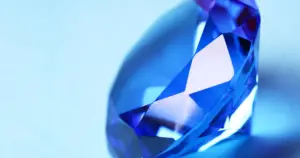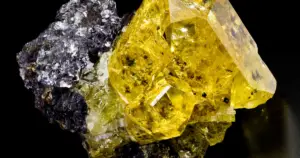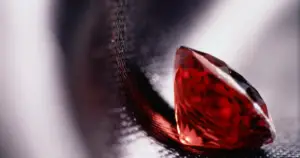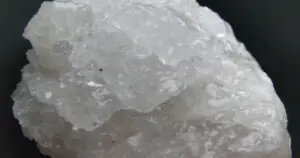Moonstone Meaning: Healing Properties, Benefits and Uses
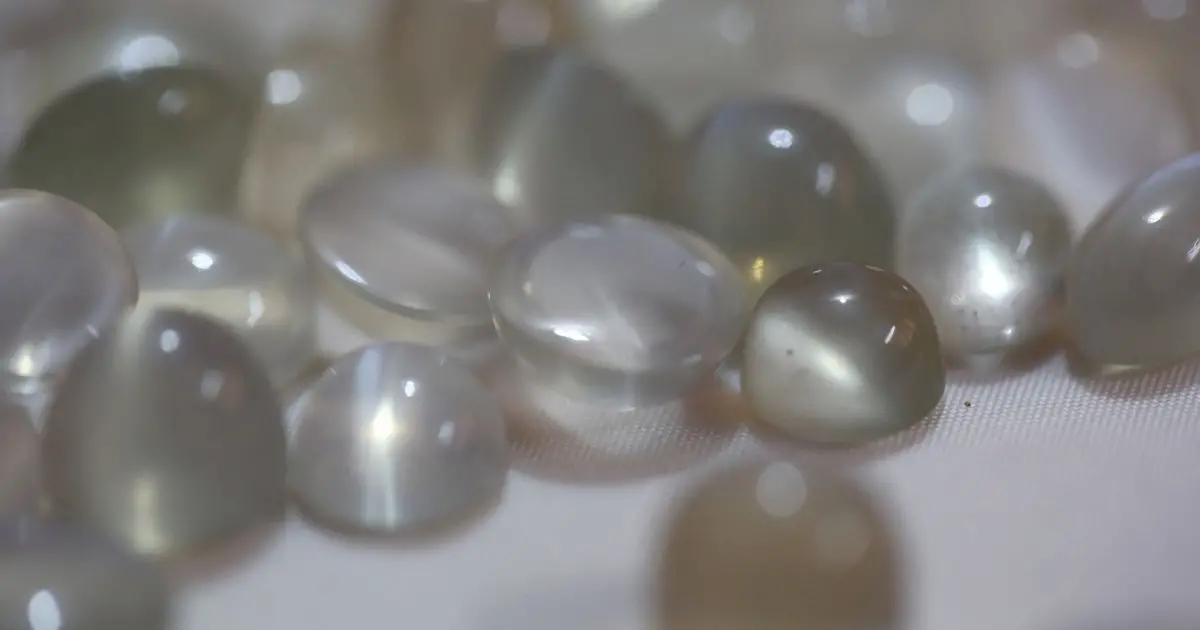
Looking for a complete guide to Moonstone? Look, no far, we have got you covered. Moonstone is a popular gemstone due to its captivating blue shine and low price. Despite its abundance, moonstone contains a large number of high-quality, difficult-to-spot fakes.
It has the power to heal and guide you down your path. When paired with the waxing and fading of the moon, it creates a sensuous, magical tranquillity. It has a dazzling vigour that may re-energize the body and mind while also removing negativity. In this blog, you will learn A to Z about Moonstone.
Interested to know about the Meaning, Healing Properties, Benefits and Uses of Black Moonstone, read here.
Table of Contents
What is Moonstone?
The name moonstone comes from the gemstone’s distinctive optical feature, adularescence (or schiller), which creates a milky, blue interior light. This effect is generated by light diffraction through the gemstone’s contrasting layers of orthoclase and albite. Based on the thickness of the albite layers, the diffracted light ranges from white to blue. This microstructure is made up of regular exsolution layering (lamellae) of various alkali feldspars (orthoclase and sodium-rich plagioclase).
Chatoyancy (“cat’s eye” effect) occurs frequently in polished moonstones, where a luminous streak emerges through the gemstone. Asterism is uncommon and results in four-legged stars. The most typical moonstone is adularia, an orthoclase basalt mineral called after an early mining location near Mt. Modular in Switzerland, currently St. Gotthard.
Watch the below video to know the top 10 properties and uses of Moonstone:
How to Identify a Moonstone?
There are other stones available on the market today, including the widely famous moonstone. This gemstone has long been known for its magical abilities and unusual beauty. Many people appreciate the jewellery fashioned from this stone.
Despite the abundance of moonstones available, some natural stones lack the same worth and qualities as genuine moonstones. However, they will appear identical, and only a professional can determine the authenticity of a genuine stone.
Several characteristics cause the consumer to mistrust the moonstone’s authenticity:
- When you shine a light on the moonstone, you can see the stratified structure inside. Layer separation is not visible in synthetic stone; it is blended.
- The pure moonstone will have a blue brilliance and, most significantly, an irisation, a flickering interior. Examine light at angles larger than 15 degrees, as moonstones cannot diffract light at angles greater than 15 degrees. A stone that glows from different angles is a forgery.
- You can also soak a stone for 1-2 hours in water. If the moonstone’s brightness and hue have risen, the stone is natural. Fakes and artificial gemstones are brighter and richer than natural stones.
- A real stone takes a long time to heat up, so holding it in your palm is likely to keep it cold. A false stone constructed of glass will quickly warm up.
- Examine the stone’s structure. If the stone is flawless and the price is reasonable, it is most likely a forgery. Natural stones are characterised by bubbles and fissures.
Remember that, while it is occasionally possible to discern whether you are gazing at a genuine stone or not, it is preferable to rely on professionals who can accurately determine the validity of the moonstone. Also, keep in mind that it is preferable to get stones from known locations with authenticity certificates.
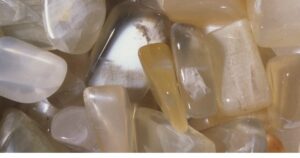
Moonstone Cuts and Shapes
- Round
Moonstones that are round mirror the full moon. The basic yet effective drawing of energy is the focal point of this cut. Similar to how a wedding band is viewed, the traditional form denotes eternity. People who prefer the round cut Traditional, trustworthy, and loyal describe moonstone. You will be illustrating magnetism and its domain effect if you select this form.
- Oval
The oval cut shows a little bit of originality while staying true to the traditional round shape. Oval shapes, likened to an egg shape, signify fertility. The marquise and round cuts can be combined to create an elongated shape. Oval evokes individualism, which might assist you in stepping outside of your comfort zone. Those that favour this cut are conventional but occasionally know when to have fun.
- Square
After the round, this form is the most prevalent cut. Square emphasises the dualism in the things around us and conveys a sense of equilibrium. It conveys a sense of rigidity and stability akin to that found in buildings’ foundations and the coherence of the cosmos. an angle cut Moonstone will inspire you to make plans and bring that idea to life. This design will give your thoughts full momentum if stasis and equilibrium are your things.
- Rectangular
A rectangular cut is similar to a square shape. Moonstone connotes logic, mathematics, order, and safety. It is a common form for accent stones in jewellery and is sometimes referred to as the baguette cut. Since it was designed in the 1920s during the Art Deco and Art Nouveau eras, with sleek and contemporary lines that evoke a geometrical flare as opposed to the customary circular, it has quickly gained popularity.
- Pear Or Teardrop
The pear or teardrop cut is created by fusing round and marquise shapes. When worn, the elliptical design creates the appearance of a thinner finger. The women that select this Moonstone cut are edgier yet still possess a delicate side. The wearer is more obviously regarded as a trendsetter even though the shape alludes to the concept of tears of joy or grief.
Where are Moonstones Found?
Moonstone belongs to the feldspar rock family. It’s an opalescent stone that comes in colourless, peach, pinkish, green, grey, yellow, brown, and blue varieties. Adularescence is the movement of light seen in Moonstone, and its purity ranges from translucent to opaque.
Moonstone deposits can be found in Armenia (mostly in Lake Sevan), Australia, Austria, Myanmar, India, Sri Lanka, Norway, Mexico, Madagascar, Poland, and the United States. Myanmar has always produced the most precious, translucent moonstones with a bright blue lustre. The majority of commercial moonstones now come from Sri Lanka.
The most authentic and unique moonstone could be found in parts of Sri Lanka and India. Because of their scarcity, blue moonstones are greatly regarded. Rainbow Moonstones are famous in India. The Adult Mountains in Switzerland have the most historically significant moonstone mining. Other mines can be discovered in:
- Myanmar,
- Tanzania,
- India,
- Brazil,
- Norway,
- the United States,
- Australia, Germany, and
- Madagascar.
Moonstone Meaning
Moonstone’s relevance lies in its vibrancy, which is as ancient as the lunar surface. This power can energise, and awaken your feminine energies.
It can heal and direct you to your internal path. It produces a sensual, mystical peace when combined with the waxing and waning of the moon.
It emanates a radiant vigour that can re-energize the body and mind while washing away negativity. Moonstone, since it is surrounded by strong rays of golden, blue, and purple, is continually hugged with brilliant white energy, making it a protective gem.
Moonstone Meaning in Ancient Lore and History
Moonstone has long been associated with the Earth’s moon. This enigmatic stone, which resembles a moonlit night, has been the subject of legends throughout the world.
Moonstone has been utilised in Roman jewellery for two thousand years. They associated the moonstone with Diana, the Moon Goddess, and claimed that wearing it would bring them love, money, and success.
There was a legend in Asia that blue moonstones were carried in by the tide every 21 years. In India, it was thought that putting a moonstone in one’s mouth at a full moon brought good luck and allowed loving partners to foresee their destiny. Moonstone is a proper wedding present in India. They also noticed that as the moon changed from a full moon to a new moon, the stone’s shine rose and decreased.
Moonstone was also said to be created from the moon’s mystical light in Hindu mythology. It was said to be a precious and mystical “dream stone” that could provide peaceful and lovely dreams at night, according to legend.
Moonstone is said to enable the wearer to experience vivid visions and prophecies, according to legend. The stone would lose its lovely shine if someone was always angry.
It was also termed the “Traveler’s Stone” since it was thought to protect anyone who wore it at night while travelling.
Moonstone’s capacity to assist users going with the flow, similar to how the moon affects the tides, is the subject of current legend.
Moonstone Healing Properties
With the Moonstone’s properties, revel in the sacred feminine, discover your great luck, and say yes to higher levels of crystal healing. This multicoloured gemstone adores bringing light into your life, and the Moonstone, such as the cosmic rock that hovers in our sky, is linked to all of our emotions, the tides, light and dark, and the recesses of our soul. Take a glance at all the methods the Moonstone may help you find balance, from the spiritual to the physical.
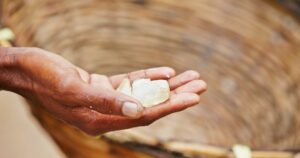
Moonstone Physical Healing Properties
- It’s no wonder that the Moonstone is associated with Goddess energy and the divine feminine, thus it might be your ticket to gentler symptoms and greater hormonal balance if you suffer from PMS.
- The Moonstone has a strong influence on the reproductive system and helps your body to return to its natural cycle.
- The Moonstone can also assist folks who are experiencing reproductive troubles in bringing these concerns to a healthier conclusion.
- Parents-to-be will benefit from the Moonstone’s strength and power, as it can assist to alleviate a variety of bodily discomforts commonly connected with pregnancy and parenting.
Moonstone Mental & Emotional Healing Properties
- If you’ve ever felt like you’re going insane during a full moon, you have a good idea of how much the Moon influences our emotional equilibrium.
- The Moonstone is here to illuminate the darkness and raise all of your emotions. When you maintain a moon sign on your body or in your life, it will naturally connect you to the cosmos and can bring all those raging hormones under control, allowing you to move in sync with the world beyond your window.
- The Moonstone is also recognised as the stone of fresh starts. Everything changes and the Moonstone encourages you to accept the cyclical nature of the elements and not to be afraid of the turning of the chapter and the possibility of new chapters.
- Rather than sinking into overwhelm, the Moonstone uses the harmony of its inherent healing qualities to help you process and accept.
Moonstone Metaphysical Healing Properties
- The Moonstone is a beautiful stone that is rich in psychic powers and a wonderful chakra connection.
- This gleaming stone has a highly spiritual quality to it, instilling in us a sense of wonder and peace similar to seeing the moonbeams dance across the midnight ocean.
- The Moonstone harmonises nicely with the Third Eye Chakra, Heart Chakra, and Crown Chakra, the two chakras that inspire us to search deep inside ourselves to see far beyond our horizons.
- When these two chakras are open and attuned, they assist us in finding our position in the cosmic universe.
Benefits of Moonstone
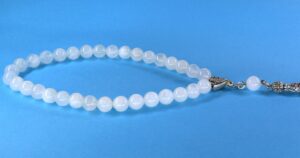
Here are some uses and benefits of Moonstone:
- The Moonstone, like the vast shining anchor of the sky, mesmerises us with its radiant feminine energy, tide-like draw, and hope of cyclical change. For millennia, the moon has been a sign of the divine spirit, hovering over our heads like an orb, sometimes a drop of light, other times as rich and abundant as harvest.
- This albite crystal is shot through with beams of light and a creamy sheen known as adularescence, and it catches all of this wonder and more. It is an orthoclase stone, which is a type of feldspar mineral.
- Moonstone has been collected from all across the world, including the tea terraces of Sri Lanka, the fanciful coastlines of Madagascar, the Aurora regions of Norway, and the wide expanse of Australia.
- The Moonstone, like the moon in our sky, has been there for countless seasonal changes. In India, the Moonstone has been used for centuries to facilitate clairvoyant and spirituality.
- The pearly lustre of Moonstone was thought to be a sliver of solid moonlight in Ancient Rome. It was thought that anyone who looked into the stone could see the Goddess Diana and that wearing this sparkling amulet would bring the bearer love and riches.
- As Europe joined the Art Nouveau era, the Moonstone once again cast its spell, and the stone saw a fresh flurry of flourish as the focus for jewellery and transcendent practices.
- The Moonstone has also appreciated anew in the swinging sixties, particularly as a spiritual instrument for healing, and even now, in our modern society, the Moonstone hasn’t lost its link with being a special amulet to propel our wellness into new dimensions.
Moonstone & Feng Shui
Moonstone’s healing energies may be brought into your house. Because of all that rich feminine energy, Moonstone’s charm may be a fantastic contribution to your Feng Shui practice. The Moonstone, as previously said, symbolises heavenly and emotional equilibrium, making it an excellent stone for creating harmony in your house.
- Place the stone in areas where family or shared home tensions are likely to rise, and allow it to lower the temperature to a gentler, cooler level.
- Place your Moonstone near your bed for when you want to bring power and good balance to reproductive concerns, and place it in studios and offices to encourage a bit more creative play.
Moonstone Birthstone
Moonstone, the third birthstone for June, was given its name by the Roman naturalist Pliny, who noted that the stone’s shimmering look changed with the moon’s phases.
Moonstone Chakras
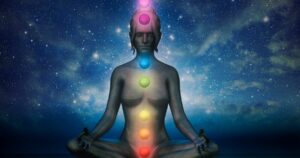
Here are the chakras linked to Moonstone:
- The upper chakras are associated with the Moonstone. It’s connected to the crown chakra, which is our most significant chakra for big-picture thinking and connecting to the universe.
- It’s also related to our third eye chakra, which serves as a portal to our inner wisdom while also bolstering our intuition. Moonstone also helps us to heal past scars, cultivate compassion, and be receptive to accepting and giving love by working on the heart chakra.
Summary of Moonstone Crystal
| Name of Crystal | Moonstone |
| Other Names | Selenite |
| Origin(s) | Sri Lanka |
| Color(s) |
White, Blue, Green, Yellow, Brown, Colorless
|
| Precious | No |
| Semi-Precious | Yes |
| Formation |
Forms When Magma Cools
|
| Majorly Found at |
Madagascar, Australia, Brazil, Mexico, Germany, Switzerland, India
|
| Zodiac Suited for | Gemini |
| Healing Properties |
Emotional Stability, Calmness
|
| Health Benefits |
Fertility Aid, Affects Reproductive Cycle
|
| Types of Crystal |
7; Silver Moonstone
Purple Moonstone Blue Moonstone Rainbow Moonstone Green Moonstone Pink Moonstone White Moonstone |
| Uses |
Enhances Intuition, Promotes inspiration
|
| Goes in the Water? | Yes |
| Goes in Salt Water? | Yes |
| Goes in Rain Water? | Yes |
| Goes in Moon Water? | Yes |
| Moh’s Scale | 6-6.5 |
| Real |
Different layers in its structure, Blue shine
|
| Fake |
|
Moonstone Uses
- Wear it to cleanse your chakras and embrace change.
- Welcome to the place where you may have fun with your creativity.
- Keep by the bedside to help with fertility.
Those who wish to wash away bad energy, reset emotions, and say yes to more feminine feelings in their lives will enjoy this watery white and brilliantly bright stone, whether they bring it into their house or opt for it as the centrepiece for their gemstone jewellery. Here are some of the most effective methods to say yes to Moonstone
Moonstone Cleansing: When to Cleanse Moonstone?
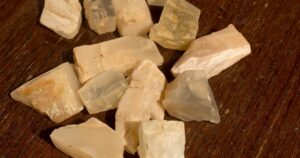
You should cleanse Moonstone on a full moon or a new moon.
Here is how to cleanse your Moonstone:
- Your Moonstone, like other gemstones and healer crystals, will operate best if it is cleansed and charged regularly.
- Healing crystals are constantly soaking up bad energy and transmitting our positive energy, and you may wish to wash away those negative vibrations from time to time to maintain this flow fresh and fully functioning.
- Moonstone reacts nicely to the mixture of water and moonlight, just like the moon hovering in the sky.
- Simply purify your Moonstone’s energy by submerging it in water, then place it on a windowsill or near the waxing or full moon to absorb the rays.
How to Recharge Your Moonstone?
Here is how to recharge a Moonstone:
- The greatest approach to re-energize your moonstones once they’ve been cleansed is to use the moonlight.
- Merely leave the stones out by the window overnight so the moon can give them renewed energy.
What is Moonstone Activation Process?
Here is how to activate Moonstone:
- Place your stones near the window overnight.
- Let the moon infuse them with new vitality
- To get better Moonstone crystal properties, a full moon is best.
- If you’re concerned about negative energy being absorbed by the moonstone, you can always use cinnamon or incense to waft away any bad energy.
How much is Moonstone worth?
Starting at about $10 per carat, moonstones are relatively inexpensive. Based on the quality, i.e., Color, Clarity, Cut, and Shape, it can cost up to $30 per carat. The validity and originality of the moonstone will determine its price. They ought to be genuine and unique.
What determines the price and value of Moonstone?
The value of a moonstone differs from that of several other coloured gems. Because the main value of moonstone derives from its otherworldly glimmer, the 4 C’s that apply to the realm of jewellery, colour, clarity, carat, and cut, apply differently.
Gem-quality moonstones range in price from $10 per carat to $30 per carat on the high end. You should expect to pay $250 for a high-quality ring or tiny bracelet of average size. The price is determined by the amount of adularescence present. Blue adularescence is the most precious, and it usually comes from Sri Lanka or India.
Does Moonstone make a Good Jewellery Stone?

Moonstone is quite adaptable and goes with many different forms of jewellery. Moonstone may be made into elegant, traditional jewellery in addition to being frequently utilised in boho styles.
Moonstone jewellery is the finest method to bring Moonstone’s power into your life if you want to make the most of it. Having the stone put directly against your skin, whether it’s a spectacular glowing Moonstone necklace or a lovely Moonstone ring on your finger, enables optimum absorption of its power.
When gemstones are put on the body, they can interact with your body’s inherent frequencies, sending healing vibrations where they are required.
The protecting energy of Obsidian, the sparkle of Opal, the brilliant nature of Labradorite, and the tranquil vibrations of Amethyst are all stones that compliment the Moonstone.
Real vs Fake Moonstone
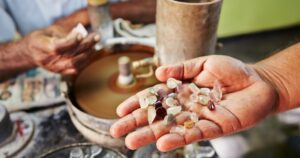
Here is how to identify if a Moonstone is real or fake:
- The most appealing adularescence appearance, which is blue and white-coloured light that seems to billow over a gemstone, is seen in real moonstones.
- Fake moonstone has a similar phenomenon; nonetheless, we’re here to show you how to tell the difference between the real mystically gorgeous gemstone and the fake.
- Moonstone belongs to the feldspar mineral family. Moonstone is an intergrowth of members of the feldspar group (albite and oligoclase). It features microscopic parallel layers or fractures that are occasionally perpendicularly crossed by other fractures. Fractures and inclusions can be found in real Moonstones.
- Moonstone belongs to the feldspar mineral family. The most frequent minerals in the Earth’s crust are feldspars. They are composed of the following three elements:
- Orthoclase – KAlSi3O8
- Albite – NaAlSi3O8, and
- Anorthite – CaAl2Si2O8.
- The gemstone variation name moonstone can be given to any feldspar with adularescence. Moonstone is made up of two types of feldspar: orthoclase and albite.
- During crystallisation, these two species mix. They generate closely spaced layers that disperse light rays in various directions due to the diffraction process, resulting in the adularescent phenomena.
- Adularescence causes a polish moonstone’s surface to shine with light-blue and white colours, like Moonlight. During the action, the created misty light also appears to roll from across the cabochon surface.
- The most precious stones are those that are flawless, transparent, or translucent and have a beautiful blue lustre. To best show off this look, moonstones are usually cut as cabochons or sculpted. Sri Lanka, Burma, Tanzania, and India produce the best moonstone gems.
Final Thoughts on Moonstone
Moonstone is a fantastic gemstone to have in your collection. The Moonstone may be exactly the gem to offer radiant light that cuts through the darkness to individuals who desire a bit more goddess energy, who would like to stay tuned to the greater picture, and who may need a little more support when it comes to accepting good energy surrounding transition.
FAQs
Is Moonstone a crystal?
Moonstone is a type of feldspar. It is constructed of sodium potassium aluminium silicate and is made up of albite and orthoclase, two distinct feldspar minerals. Moonstone is a mineral that is also known as a crystal mineral.
Is Moonstone a costly gemstone?
The price of a Moonstone varies, although it is generally regarded to be a reasonably priced stone. Moonstone is available for $10, however, the better the quality of the gem, the higher the price. If the Moonstone is of sufficient clarity, it can sell for $1000 or more.
What do Moonstones do?
Moonstones are mystical jewels that are said to represent introspection. The Moonstone, like the moon in the deepest of nights, inspires us to go deep inside and connect to our core. These gleaming diamonds intensify our emotions in a way that aids us in sorting things out. They also help us accept themes of truth and transformation by connecting us to our feminine energy.
What does Moonstone symbolize?
Moonstone is associated with the notion of the feminine divine, which is one of its key themes. It helps us to move into our feminine or yin essence. It helps us to balance our moods, embrace cyclical development, and continue in tune with our instincts. It can also represent vision, equilibrium, seasonal transitions, and a deep sense of tranquillity.
Does Moonstone glow in the dark?
The Moonstone, like the orbs that brighten up the sky, possesses adularescence, which gives it a soft glow. This gem, on the other hand, does not include phosphorescent elements, therefore it does not shine in the dark.
How to clean Moonstones?
Simply running your Moonstone underwater is one of the finest and quickest methods to cleanse it. Running it underwater can clear any built-up energy or obstructions, allowing the gem to perform at its best. Moonstone can also be discharged by smudging it or using a chanting bowl.
How to cleanse Rainbow Moonstone?
When it comes to washing, all gemstones require a gentle touch. Running your Rainbow Moonstone under lukewarm water for a few seconds and then drying it with a soft towel is the best method to keep it clean. If you don’t want to use water, non-invasive techniques like smudging, noise baths, and leaving it in the company of other crystals such as clear quartz and selenite can be used instead.
Is Moonstone Opal?
Moonstone and opal are not the same gemstones, yet they do have certain characteristics in common, including colour and themes of purity and serenity. The opal, on the other hand, is frequently found in Australia and contains more water than the Moonstone. The Moonstone is a gemstone associated with femininity and new horizons, whereas the opal is associated with trust and kindness.
What are Moonstones good for?
Moonstones are wonderful for balancing energy, calming and tempering emotions, and connecting you to feminine divinity. Moonstone can help you embrace your feelings without getting drowned out by them if you have high yang energy or battle with overload. It’s also helpful for PMS, fertility, and childbirth issues.
What is Moonstone for?
Moonstones may be used for a variety of purposes. It may be used to open the crown chakra and cleanse the third eye. It may be used to harmonise and balance the yin and yang energies in your body. It can be used to aid with fertility, PMS, and hormone disorders. It may also be utilised to bring you closer to the divine feminine, promote harmony, and inspire you to welcome fresh beginnings.
What is Rainbow Moonstone?
Rainbow Moonstone is a kind of feldspar. While it is formally not a Moonstone variant, it is so identical to Moonstone that it is now classified as such, although it is a type of labradorite. The Rainbow Moonstone features a rainbow of hues flashing beneath its surface and is believed to promote balance, peace, and compassion.
What does Moonstone help with?
It assists with PMS and fertility on a physical level. It can help you emotionally by balancing your hormones and encouraging you to embrace change and new beginnings. It is a spiritual stone that promotes intuition, clarity, and a link to the divine feminine. It also has connections to the heart, third eye, and crown chakras.
How to polish raw Moonstone?
You will need a rock tumbler. If you don’t have recourse to a rock tumbler, you may polish it by hand, starting with the coarsest sandpaper and working your way up to a finer grit. After that, polish and rub it with a clean cloth to give it that beautiful sheen.
